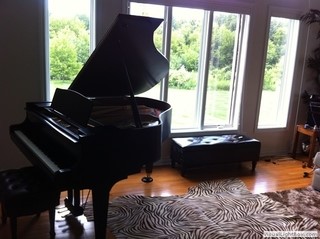Where Should I Put My New Piano?

PIANO SAFETY
To keep your piano in top condition, locate an area with minimum direct sunlight and air duct exposure. Consider your room’s door placement and traffic flow to avoid unnecessary spills or dings.
Windows
It can be great to have a view of the outdoors while playing your piano but, beware of direct sunlight and extreme temperature changes. Best case scenario, a piano finish will begin to fade in direct sunlight. Worst case, it can cause the wood to dry and crack. Additionally, the glue holding the joints together can begin to break down.
If you have no choice but to place your piano in an area of direct sunlight, a piano cover may be your best solution. Piano covers can be made of vinyl, felt, or quilted fabric. A good cover is purchased according to the piano make and model for perfect fit. Prices range from $150 - $200 on average. Obviously, blinds are an option if you don’t mind living in the dark for the sake of your piano.
Air Ducts
Climate control is a benefit in most areas, unfortunately, direct forced air from heating and air conditioning vents can present a real problem for a piano. Arranging your instrument as far away from air ducts as possible is extremely important. The rapid changes in temperature from being too close to vents can cause expansion and contraction of both the exterior wood and interior components at different rates. A piano experiencing these rapid changes will need more frequent tuning and adjustments. When we think about the interior of a piano, we picture metal and cast iron. The bigger consideration in this case are the strings, which will stretch, and the hammers, which are made with tightly compacted felt over wood.
If your piano must go near a vent and there is any way to close it, that would be the first step. There are flow deflectors that can push the air from a floor register straight out but, the air temperature will still fluctuate in the immediate area. Vent extenders can push the air flow up to 36” away from the source. These are typically mail-order items but may be the best option for smaller rooms without many choices.
Door Placement and Traffic Flow
This may seem obvious but, consider how you live, not just the logistics of your home. Are you considering placement next to an often-used closet? The door may hit the piano more than you expected. Open concept homes may have more options but, are they close to food and drink areas? Proper planning goes a long way in keeping your piano in tip top shape.
SOUND QUALITY
Upright Pianos - An upright is typically placed against a wall, preferably an interior one. The majority of the sound comes from the back so you may want to pull it out from the wall a bit for better sound reflection. It has been debated that uprights should not be against a wall but, many say the additional sound is trumped by too much ‘mechanical’ noise.
Grand Pianos - We’ve seen grand placement in a variety of places. For best sound in a room it is suggested that the long side of the piano be closest to any walls. The lid should open toward the room or the audience you will play for. Think of it as the lid to a treasure box you want to display. If you have hard flooring, you may consider a rug under the piano. Many piano owners say the tone and quality of your piano may need be the determining factor. If you’re not sure, try putting a comforter under the piano to check for differences in volume and sound quality. You may decide it sounds better without.
Recommended Dos – Place the long side on an interior wall, allow the lid to open toward the room, face the room or a view not a wall
Recommended Don’ts – Place the long side against an exterior wall, place too close to windows, open the lid toward a wall, face a wall
ROOM PLACEMENT
If you want to enjoy playing your piano, you need to enjoy its location! What inspires you when you play? Would you like to see the room and your audience? Maybe you have a great view to admire!
Keeping all the safety factors above in mind, choose a spot that makes you happy and keeps you playing!
The number one thing we do not recommend is placing your grand piano so that it faces a wall. It may be very convenient to sit and play but, you’ll miss out on what’s happening in the room or outside of that beautiful window. Additionally, when a grand piano is positioned like this, it is hard to open the lid in a way that will make the sound resonate in the desired direction.
In a perfect world you will place your piano on an interior wall, away from direct sunlight and ventilation ducts, and in a location with an excellent view. If you don’t have these ideal conditions, try the solutions above and enjoy your new piano!
NOTE: All recommendations provided by Modern Piano Moving are to be used as a guideline only. Please contact your technician for specific details regarding any questions about the conditions in your home.



